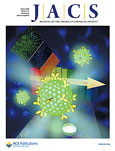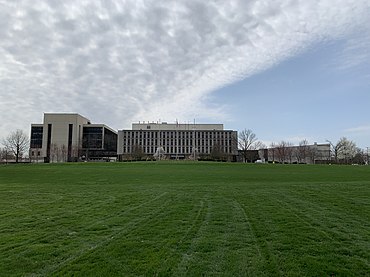
A CAS Registry Number is a unique identification number assigned by the Chemical Abstracts Service (CAS), US to every chemical substance described in the open scientific literature. It includes all substances described from 1957 through the present, plus some substances from as far back as the early 1800s. It is a chemical database that includes organic and inorganic compounds, minerals, isotopes, alloys, mixtures, and nonstructurable materials. CAS RNs are generally serial numbers, so they do not contain any information about the structures themselves the way SMILES and InChI strings do.

The American Chemical Society (ACS) is a scientific society based in the United States that supports scientific inquiry in the field of chemistry. Founded in 1876 at New York University, the ACS currently has more than 155,000 members at all degree levels and in all fields of chemistry, chemical engineering, and related fields. It is one of the world's largest scientific societies by membership. The ACS is a 501(c)(3) non-profit organization and holds a congressional charter under Title 36 of the United States Code. Its headquarters are located in Washington, D.C., and it has a large concentration of staff in Columbus, Ohio.

The Journal of the American Chemical Society is a weekly peer-reviewed scientific journal that was established in 1879 by the American Chemical Society. The journal has absorbed two other publications in its history, the Journal of Analytical and Applied Chemistry and the American Chemical Journal. It covers all fields of chemistry. Since 2021, the editor-in-chief is Erick M. Carreira. In 2014, the journal moved to a hybrid open access publishing model.

Advances in Physics is a bimonthly scientific journal published by Taylor & Francis that was established in 1952. The journal is also issued as a supplement to the Philosophical Magazine. Peer review is determined on a case-by-case basis. The editors-in-chief are Paolo Radaelli and Joerg Schmalian.

Nature Materials, is a peer-reviewed scientific journal published by Nature Publishing Group. It was launched in September 2002. Vincent Dusastre is the launching and current chief editor.
CODEN – according to ASTM standard E250 – is a six-character, alphanumeric bibliographic code that provides concise, unique and unambiguous identification of the titles of periodicals and non-serial publications from all subject areas.

Advanced Functional Materials is a peer-reviewed scientific journal, published by Wiley-VCH. Established in February 2001, the journal began to publish monthly in 2002 and moved to 18/year in 2006, biweekly in 2008, and weekly in 2013.
Natural Product Reports is a monthly peer-reviewed scientific journal published by the Royal Society of Chemistry. It publishes reviews commissioned by the editorial board on all areas of natural products research. The Executive Editor is Richard Kelly.
FIZ Karlsruhe — Leibniz Institute for Information Infrastructure, formerly Fachinformationszentrum Karlsruhe, is a not-for-profit company with the public mission to make sci-tech information from all over the world publicly available and to provide related services in order to support the national and international transfer of knowledge and the promotion of innovation. The service institution is member of Gottfried Wilhelm Leibniz Scientific Community, a union of German research institutes. The institute provides information services and infrastructure for the academic and research community and maintains a collection of scientific databases.
Ei Compendex is an engineering bibliographic database published by Elsevier. The name "Compendex" stands for COMPuterized ENgineering inDEX. It covers scientific literature pertaining to engineering materials. It started in 1884 under the name Engineering Index (Ei) and its first electronic bulletin was issued in 1967. Elsevier purchased the parent company Engineering Information in 1998.

Acta Biochimica et Biophysica Sinica (ABBS) is a peer-reviewed, scientific journal, which publishes original research articles, short communications, and reviews in the fields of biochemistry and biophysics. Established in 1958, the journal is sponsored by the Institute of Biochemistry and Cell Biology, an institute of the Chinese Academy of Sciences, and is published monthly by Oxford Journals and was published by Blackwell Publishing prior to January 2009.

Chemistry of Materials is a peer-reviewed scientific journal, published since 1989 by the American Chemical Society. Chemistry of Materials is currently indexed in: Chemical Abstracts Service (CAS), SCOPUS, EBSCOhost, British Library, Swetswise, and Web of Science. It was founded by Leonard V. Interrante, who was the Editor-in-Chief until 2013. Jillian M. Buriak took over as Editor-in-Chief in January 2014.Editor Profile - Chemistry of Materials - ACS Publications. She was followed by Sara E. Skrabalak, who assumed the position of Editor-in-Chief in November 2020.

ACS Nano is a monthly, peer-reviewed, scientific journal, first published in August 2007 by the American Chemical Society. The current editor in chief is Xiaodong Chen. The journal publishes original research articles, reviews, perspectives, interviews with distinguished researchers, and views on the future of nanoscience and nanotechnology.

Journal of Chemical Theory and Computation is a peer-reviewed scientific journal, established in 2005 by the American Chemical Society. It is indexed in Chemical Abstracts Service (CAS), Scopus, British Library, and Web of Science. The current editor-in-chief is Laura Gagliardi. Currently as of the year 2022, JCTC has 18 volumes.
The Journal of Physical Chemistry Letters is a peer-reviewed scientific journal published by the American Chemical Society. The editor-in-chief is Gregory D. Scholes at Princeton University. The Journal of Physical Chemistry Letters covers research on all aspects of physical chemistry. George C. Schatz was editor-in-chief from 2010 to 2019.

Advanced Engineering Materials is a peer-reviewed materials science journal that publishes monthly. Advanced Engineering Materials publishes peer-reviewed reviews, communications, and full papers, on topics centered around structural materials, such as metals, alloys, ceramics, composites, plastics etc..
Chemical Engineering and Biotechnology Abstracts (CEABA-VTB) is an abstracting and indexing service that is published by DECHEMA, BASF, and Bayer Technology Services, all based in Germany. This is a bibliographic database that covers multiple disciplines.
Chemisches Zentralblatt is the first and oldest abstracts journal published in the field of chemistry. It covers the chemical literature from 1830 to 1969 and describes therefore the "birth" of chemistry as science, in contrast to alchemy. The information contained in this German journal is comparable with the content of the leading source of chemical information Chemical Abstracts Service (CAS), which started publishing abstracts in English in 1907.

ACS Photonics is a monthly, peer-reviewed, scientific journal, first published in January 2014 by the American Chemical Society. The current editor in chief is Romain Quidant. The interdisciplinary journal publishes original research articles, letters, comments, reviews and perspectives.
Polymers is an international peer-reviewed open access scientific journal of polymer science that provides an interdisciplinary forum for publishing papers which advance the field of polymerization methods among others. It was established in 2009 and is published monthly by MDPI. The editor-in-chief is Alexander Böker.















